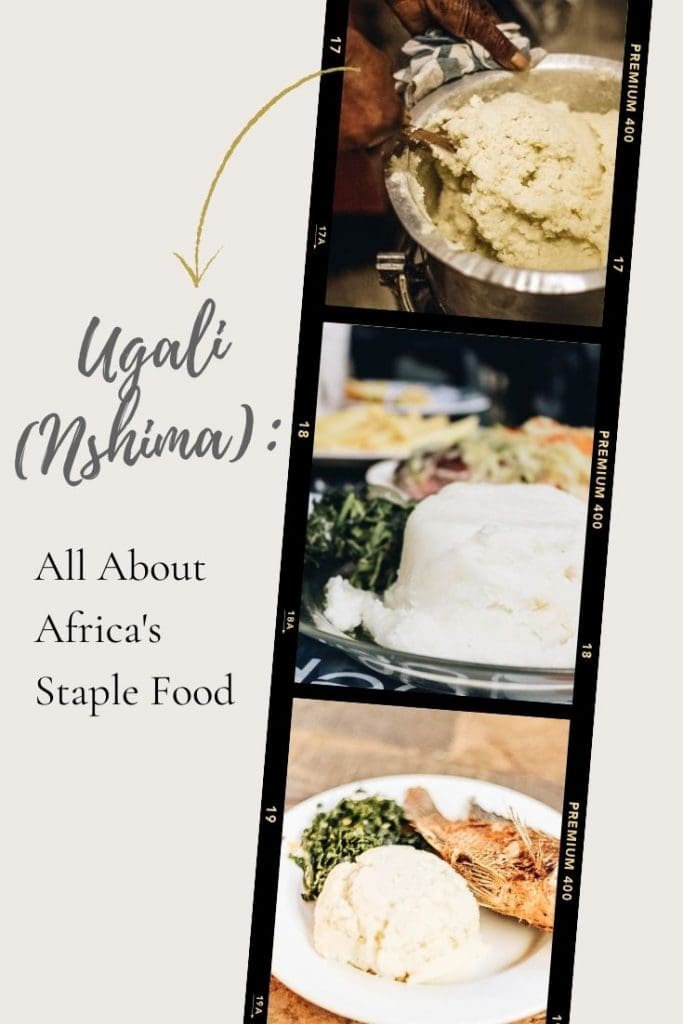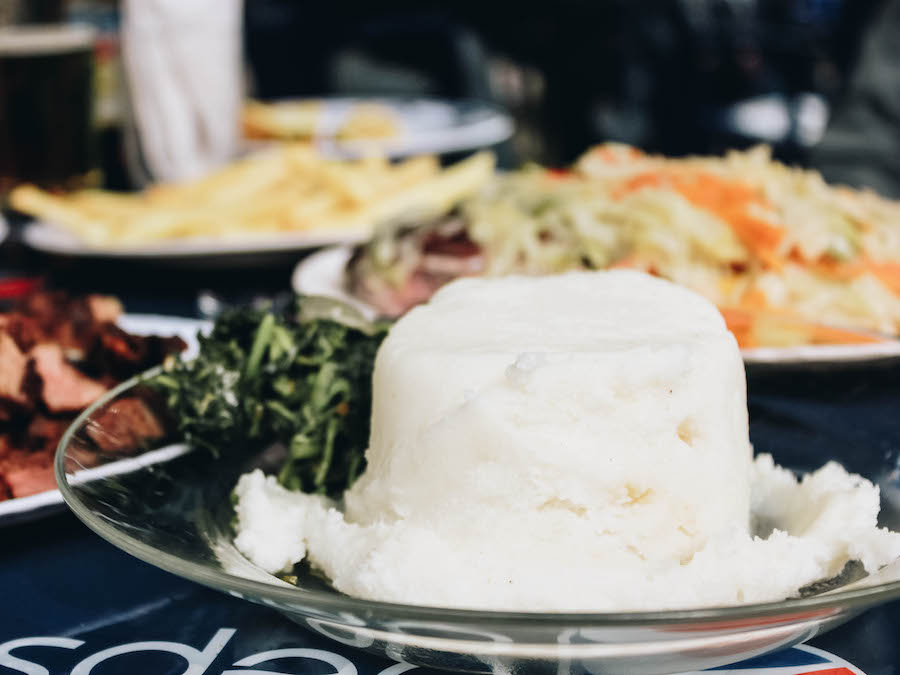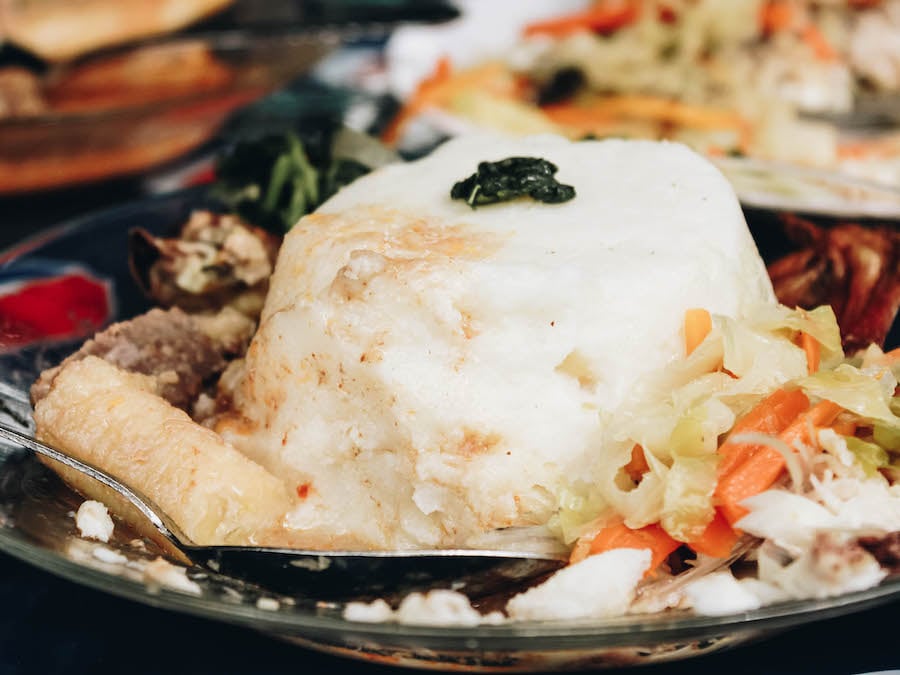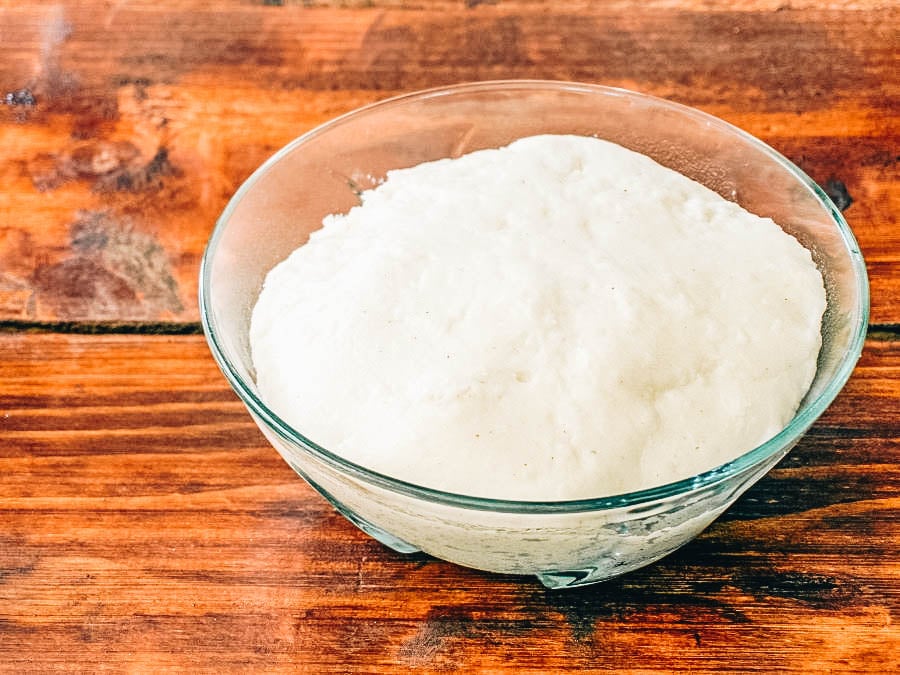If you’re traveling just about anywhere on the African continent, it’s hard not to end up eating one food in particular at some point: Ugali. Or Nshima, or Sagtulga, or whichever name this staple dish goes by in each respective country (I got a taste of it while on Safari in Tanzania!). From easy access to the flour it’s made with, to the simplicity of cooking the food, it’s no wonder it’s so loved all across Sub-Saharan Africa.
But what really is Ugali, you may wonder? How is it made and with what? Do you eat it on its own or pair it with other foods? If so, what should you eat it with? And what’s the recipe to follow if you wish to try it on your own? All of your questions will be answered below.

Ugali (Nshima): All About Africa’s Staple Food— Including Recipes
What is Ugali?
Like the title suggests, Ugali is a staple of many African countries’ kitchens. In essence, it is African style porridge. The word ugali derives from Swahili, and most countries also have a local name they like to use when speaking of the food.
What is Ugali Made Out Of?
Typically ugali is made of either corn flour or cassava flour. In the case of nsima, which is how the people of Malawi and Zambia refer to ugali, millet flour or sorghum flour may also be used. The flour is cooked in boiling water or milk until reaching a consistency similar to dough.
What are the Variations of Ugali?
Several countries have their own variations of Ugali. In Ghana, the dish is called Sagtulga, and in it the corn (aka: maize) flour is cooked with water, with a little bit of dried cassava flour mixed in, as well as prepared with millet dough, and then eaten together with vegetable soup. In Malawi and Zambia the dish is called Nshima, in which maize flour is cooked in water until reaching a porridge-like consistency, after which it’s turned into a paste of sorts, eaten with meat and vegetables. In South Africa, the dish, called Pap, is made from coarsely ground maize flour, and is eaten in various ways. And in Nigeria, the food is called both akamu and ogi, and is made to a similar consistency than an American style pudding would be, served with either bean pudding or bean cake.
History of the African Dish Ugali
The history of Ugali began from when maize (corn) made its way to the African continent from the Americas, sometime between the 16th and 17th century. Originally sorghum and millet were the cereals primarily used; however, it didn’t take long after the arrival of maize for it to become the staple cereal used, especially in the drier parts of Africa and its Sub-Saharan region.
By the latter half of the 20th century, maize had all but replaced the other crops in use. When making nshima, sorghum flour may still occasionally be used, just as cassava flour replaces maize in regions where there are low yields for maize.

What does Ugali Mean in English?
Although this is not its exact meaning, the English name for Ugali that you might find from a menu is “cornmeal mush”. It does sound like an accurate way of describing this simple staple dish, however! You may also refer to it as “maize porridge”.
How to Make Ugali
Ugali isn’t a difficult dish to make, if you’re interested in trying it at home. You also don’t need to purchase many ingredients to get started. It’s also entirely up to you whether you what you wish to serve it with, be that fish, meat, or vegetables.
Ingredients and Traditional techniques to Making Ugali:
The basic ingredients to make Ugali are as follows:
- 1½ cup(s) flour (preferably maize meal flour or cornmeal)
- 2 cups water
Here is an Ugali recipe that follows the traditional technique:
- Bring the water to a boil.
- Once the water is boiling, start to slowly add the flour in, stirring regularly.
- Reduce the heat to a medium low and continue stirring. If there are any lumps remaing in the porridge, then smash them with a wooden cooking stick or spoon (traditionally a stick called mwiko is used).
- Finally, the food will begin forming a dough-like lump. You will mix and knead the dough, squeezing out the lumps, and rolling it from side to side. This may take even up to 15 minutes, but it’s worth it if you want your Ugali to turn out properly cooked in a smooth and firm consistency!
- Once you think your Ugali dish is ready, you may remove it from the pot, and serve with your side dishes of your choice. You may serve it as it is, or you may mold it into a shape.
How is Ugali Traditionally Served & Eaten in Africa?
The ideal consistency for your ugali is one that’s firm enough you’ll be able to take it in your hands and use it to pick up the meat, fish, or vegetables you’re serving with it. You can also use a fork, but hands are the traditional way to eat foods like these!
Typically, a piece is pulled off the lump or loaf-shaped Ugali, and this is then dipped into a stew or sauce that’s been made with vegetables or meat. Instead of simply dipping, Ugali is often also used to pick up the pieces of meat and vegetables in the sauce.

What Does Ugali Taste Like?
It may depend on the individual somewhat how they perceive the taste of Ugali to be like. To others, its taste mildly resembles that of popcorn, while to others it may seem entirely tasteless. I thought it was similar to a polenta. When someone wants to add a bit more flavor to their Ugali, they’ll add in butter and milk, but traditionally it is eaten as is, regardless of its mild taste.
Ugali Recipes
I’ve already laid out some basic instructions for how to make Ugali, but the below recipes also come with excellent step by step picture guides. These may make it even easier for you to follow through the process!
- How to cook the perfect Ugali by Mulunga Alukwe
- Ugali (Corn Fufu) Recipe by Immaculatebite
Next time you visit a restaurant cooking foods from an African country, don’t forget to sample Ugali! If you’re about to visit the African continent, its mild taste makes it a great place to also start eating your way through the local cuisine. If you’ve ever eaten polenta, for example, ugali will even seem and feel a little bit familiar to your taste buds. Whatever the case, each country in Africa is rich with their cuisines, and you’ll be having the time of your life exploring the different foods!
My Experience in Africa with Ugali
I couldn’t possibly travel all the way to Africa without indulging in a bit of the traditional food culture and, while in Tanzania, that meant eating Ugali. Ugali is a stiff porridge made from maize flour (corn meal) and has many similarities to the more familiar Italian polenta.
After our Shadows of Africa safari had ended, tour owner Natasa indulged us in another memorable experience, a trip to a truly traditional outdoor eatery. Arusha City Park featured local dishes, including Ugali.
We arrived to dozens of wobbly tables which were set with Pepsi tablecloths and blue plastic chairs. The country music of Dolly Parton was playing on the radio. Interesting choice. We took a seat at one of the vacant tables and it was table service from then on, albeit poli poli (slowly, slowly). Poli poli was a term we’d gotten used to while in Africa. No one appeared to be in much of a hurry, which was okay because neither was I.
Timothy, our safari driver and native Tanzanian, did the ordering. He also answered our two dozen food related questions. Just like he did with the animal inquiries while on safari in Serengeti.
- Ugali ng’ombe Choma – Diced barbecued beef with all the parts of the animal. When I asked which parts where included, all he said was “you don’t want to know”.
- Ugali Kuku Choma kienyeji – A traditional barbecued chicken.
- Ndizi Machalari – A tasty dish with banana and beef where the bananas taste just like a potatoes.
- Chips: The chips (aka: French fries) were an odd companion to the rest of the meal, but some sort of potatoes were served with every other meal I had in Africa too.
He ordered a selection of dishes for sharing;
Ugali Samaki – Samaki means fish and in this case that fish was talapia. The whole fish was served covered with cabbage.
Prior to eating I made my way to an orange thermos that was set up to the side for hand washing. Soap was found in an old water bottle with a hole punched in the top for easy dispensing.
Hand washing is always important, but much more so in Africa because here they eat with their hands. Even though we knew this, we asked for forks. They gave us spoons. We ate with our hands. Turns out they are very handy utensils.
The starchy Ugali came by itself in a perfect mound in the center of the plate. I surrounded my white hill with a little from each of the share plates. I like variety. Then, as instructed, I took small sections of the cornmeal, rolled it into a ball and sopped up all the other goodies with it.
Ugali tastes similar to a standard polenta, with no seasoning. Not much flavor until you dip it into everything else.
More About Africa
Nigerian Food Bucket List: 30 Dishes to Eat From Nigeria
Freetown Bucket List: 15 Best Things to Do in the Capital of Sierra Leone
Sierra Leone Bucket List: 10+ Best Things to Do in the African Country
The African Big Five: The Top 5 Animals to Spot on Safari
African Safari in Tanzania: The Ultimate Itinerary and Tour
Africa’s Maasai Tribe: The Culture & Traditions of The People
Safari Animal Bucket List: 35 Top African Wildlife to Spot
Four Seasons Safari Lodge: Luxury in Tanzania’s Serengeti National Park
Mexican Tuna Fruit: Green & Red Prickly Pear Cactus




Thank you for explaining that you usually eat ugali with your hands. I’ve been thinking about introducing food from around the world to my kids. I’ll have to try this one out since they should be excited to eat with their hands for a full meal.